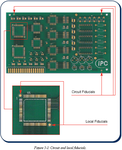mmitchell
Advanced Member level 4
Hi,
I have three questions:
For (1), if the board is an experiment board would have its BGA and other fine pitch components registered by human inspection before soldering, are fiducial points still required?
For (2), I have only seen Mitzner’s book mentioned this. Is it a must with today’s board manufacturing technology?
And how can fiducial points for purposes (1) and (2) be differentiated? I assume each fiducial point can actually serve both (1) and (2)?
Matt
- On many boards there are fiducial points. I googled this, and the purpose seems basically reference/marking points to help machine vision system to do registration.
-

- However, fiducial point concept also exist the alignment of different PCB layers. The following screenshot is from page 14 of Kraig Mitzner’s book Complete PCB Design Using OrCAD Capture and PCB Edito:

I have three questions:
For (1), if the board is an experiment board would have its BGA and other fine pitch components registered by human inspection before soldering, are fiducial points still required?
For (2), I have only seen Mitzner’s book mentioned this. Is it a must with today’s board manufacturing technology?
And how can fiducial points for purposes (1) and (2) be differentiated? I assume each fiducial point can actually serve both (1) and (2)?
Matt